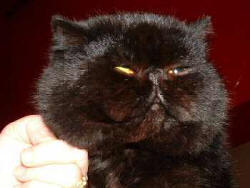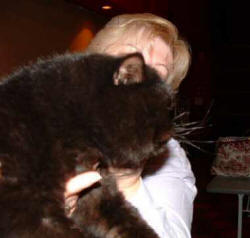|
Breed Profile

Breed: Exotic
(Persian) Shorthair
By Sue Martin 2004
Body type: Cobby
History of the breed:
The history of the Exotic started
with American breeders when in the 1920’s they began to
cross the American Shorthair with the Persian in an
attempt to give the American Shorthair a more Persian
look.
The breeding program resumed after
the 2nd World War and in Britain, breeders
used the British Shorthair to restore the Persian breed,
which had almost been wiped out.
Breed status was gained 1966 but not
with controversy – American Shorthaired breeders wanted
to keep their breed true and not have the texture of the
coat changed to plush and the Persian breeders didn’t
want this “easy-care” Persian type in their group and it
was from these two origins that the Exotic breed
emerged.
Coat texture and length, colour and
pattern:
The Exotic is basically a shorthaired
Persian with the same distinctive head and cobby body.
The coat is where the two breeds
differ, dense (stands out from the body), plush and
soft. Slightly longer than that of the British Shorthair
but fuller than is usual in shorthairs (having the
Persian long down hairs), the coat is not long enough to
flow but must be of uniform length.
Colours and patterns are that of the
Persian longhair.
Breed profile review:
Entire Male Black Exotic Shorthair
It was a pleasure to handle an
exhibit where show presentation had been a priority;
bright yellow show curtains were chosen to enhance the
black coat. What a pleasure it is to walk up to a cage
and see clean/ironed curtains, no smells and no kitty
litter sticking to an exhibit’s coat.
The first thing you noticed about
this exhibit is the condition of the coat, dense coal
black coat, that sparkles and the massive round head,
tiny ears and eyes not fully opened, just slits that
show you a hint of deep copper eyes.
Taking the exhibit from the cage to
the judging table, you are able to feel a body of good
substance, slightly heavier than its looks and in good
body condition/spine well padded. A broad deep chest
that is in proportion to size of his cobby body; his
legs are thick, indicating a heavy bone structure.
With your hand supporting the rear
end of the cat, you are able to assess the length of
body and the roundness of the rump; body length – in
proportion to leg length and rump has roundness, doesn’t
appear to be rangy or too high on the leg.
And yes he’s a “male”.
This photograph shows the short,
thick legs/large round paws.
Placed on the judging table for
further assessment, the “box-like” appearance of the
cobby body is evident, again quick assessment of the
body confirms a body of good substance and the tail is
short/round tip (in proportion to the length of the
body), no faults.
The head, broad, round and massive
and small round tipped ears that sit wide not taking
away from the round shape of the head. Eyes appear to be
rounded but this exhibit is not inclined to open his
eyes fully - colour a deep golden.
Palpating gently the skull area, from
the nose stop, over forehead and through to the back of
the head – no incorrect depressions or bumps and an
ideal Persian “dome”, round and smooth with good depth.
Smooth, semi-circular
arc.
In profile: alignment of the chin,
nose tip and forehead curve is apparent in profile –
equal not protruding further than the other.
Assessing the face:
 Round,
good breadth, full cheeks and the jaw line with good
width and round shape continues to the chin that is
firm. Round,
good breadth, full cheeks and the jaw line with good
width and round shape continues to the chin that is
firm.
Nose dead centre, eyes – level, equal
distant from nose. Centre of the bottom jaw is directly
below the nose leather. Equal distant from the nose
leather to top of head and equal distant from the nose
leather to the bottom of the chin.
The
nose- short and broad, nose leather -
I would have liked to see it slightly broader to give a
little more flare to the nostrils (this does not
distract from the exhibits breed features).
This exhibit would nearly have the
perfect show head.
Coat and colour:
A good quality jet-black coat –
shiny, plush, soft in texture and standing out from the
body. The coat length was slightly more than finger
length.
The colour was sound to the roots, no
rust or white hairs.

The final assessment of this exhibit
is that he meets the standard both in type and colour,
and excels in condition and show presentation
|















